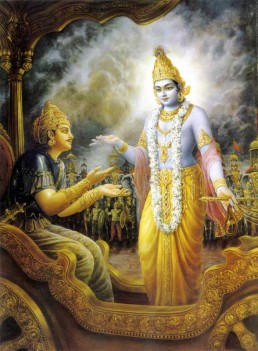Swami Chinmayananda
Swami Chinmayananda Commentary
The cosmic-wheel-of-cooperative-action is being narrated here in the familiar language of the Vedas. The living creatures are born out of food, and they are nourished by food. The mineral-wealth of the world becomes assimilable food — both as vegetarian and non-vegetarian — only by the action of rain upon it. But for rains the vegetables will not grow, and the lack of proper grazing-grounds is a danger to cattle-wealth. “Rains come as a result of Yajna, and Yajnas are performed through human action.”This stanza may read strangely to those who are not ready to bring the full shaft of their intelligence for the purpose of understanding it. It is evident to any modern educated man that living creatures are born out of matter. Matter is rendered consumable and digestible, nutritive and assimilable, only by the action of rains upon it. But the difficulty in understanding the stanza is when we come to the next assertion that “the rains come as a result of Yajnas.”
But in Krishna’s words here, we are not warranted in accepting that he is advising Arjuna to follow ritualism. In this stanza, as also elsewhere all along the Geeta, the familiar terms of the Vedic period has been charged with new meanings and significances. “Rain” is the essential condition for the conversion of the mineral-raw-material into enjoyable and nutritive food. Similarly, in all fields of activity there is “an enjoyable profit” which can be gathered only when the fields come under “conditions favourable” for them to produce those profits. “Self-dedicated activities” (Yajna), when performed in any given field of endeavour, will be creating therein “conditions necessary for the field to smile forth” (rain) in a luxurious “crop of profit” (Annam), enjoyable by the society.
For example, the wasteful waters of a river flowing idly can be dammed and made use of, if the waters are intelligently employed in irrigating the fertile lands now lying fallow on its banks. Through sacrifice and work alone can the dam be built and when it is built, it provides “conditions helpful” for bringing the lands on either side under the plough. Again, for making use of irrigated land, man has yet to strive: ploughing, sowing, weeding, waiting, gathering — before he can come to enjoy the profit of his activities, the food.
We are shown how this Wheel-of-Action (stanza-15), is connected with and includes the Supreme. The principle of right action, nay, even the power to act, has come out of the Creator himself and the Creator is none other than the Imperishable Supreme. Action IS in the new-born live baby; action is a gift from the Creator! Therefore, the All-pervading Supreme is ever centred in all undertakings pursued, by one or many people, in an honest spirit of Self-dedication, for the good of all.
HE, WHO LIVES IN UNISON WITH THIS WHEEL-OF-ACTION, IS CONTRIBUTING TO THE HARMONY OF LIFE. WHAT HAPPENS TO HIM WHO DISOBEYS?
Adi Sankara Commentary
Again, [a different reading in place of this is: ‘Tat ca vividham karma kuto jatamityaha, From where did those various kinds of action originate? In reply the Lord says…’ Still another reading is: ‘Tat ca karma brahmodbhavam iti aha, And the Lord says: That action has the Vedas as its origin.’-vide A.A., 1936, p. 116). Astekar’s reading is: Tat ca evam vidham karma kuto jatamityaha, And from where has this kind of aciton originated? The answers this.’-Tr.] viddhi, know; that karma, action; is brahmodbhavam, it has Brahma, the Veda, as its udbhavam, origin. [Here Ast. adds ‘revealer’-Tr.] Further, Brahma, called the Veda, is aksara-samudbhavam, it has aksara, the Immutable, Brahman, the supreme Self, as its source. This is the meaning. Since the Veda came out, like the breath of a man, from the supreme Self Itself, called the Immutable, therefore the Veda, being the revealer of everything, is sarva-gatam, all pervading. Even though all-pervading, the Veda is nityam, for ever; pratisthitam, based; yajne, on sacrifice, because the injunctions about sacrifices predominate in it.
The Bhagavad Gita with the commentary of Sri Sankaracharya – Translated by Alladi Mahadeva Sastry
Holy Geeta – Commentary by Swami Chinmayananda
The Bhagavad Gita by Eknath Easwaran – Best selling translation of the Bhagavad Gita
The Bhagavad Gita – Translation and Commentary by Swami Sivananda
Bhagavad Gita – Translation and Commentary by Bhaktivedanta Swami Prabupadha
Srimad Bhagavad Gita Chapter 3 – Verse 15 – 3.15 karma brahmod – All Bhagavad Gita (Geeta) Verses in Sanskrit, English, Transliteration, Word Meaning, Translation, Audio, Shankara Bhashya, Adi Sankaracharya Commentary and Links to Videos by Swami Chinmayananda and others – 3-15

